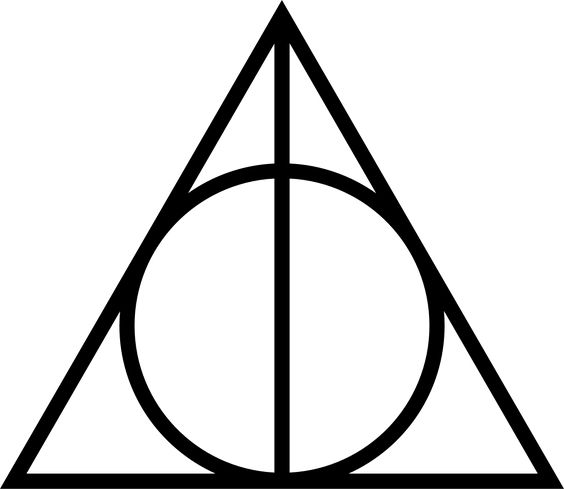Automorphisms Don't Extend
30 Nov 2020 - Tags: sage
I was on mse last night (later than I should have been…) when I saw a really interesting question. In the interest of keeping the blog post self contained, I’ll transcribe the question here (with some notational edits):
Let
Is
If not, is there a necessary and sufficient condition for this to hold?
I think automorphism groups are really interesting. They’re a very natural
operation on groups, and yet they seem to be quite difficult to understand
in general. I haven’t done any extensive work with them, but the fact that
they’re so difficult to compute surprises and excites me. Moreover, if a group
My instinct, upon seeing this problem, was to answer “no”. That is,
there’s no reason
One picture you might have in mind is this2:

The circle has LOTS of symmetries, but the deathly hallows logo3 has only two. The “do nothing” symmetry, and the “reflect horizontally” symmetry. Most of the symmetries of the circle don’t extend to symmetries of the entire object, and there’s no reason to expect symmetries of groups to behave any differently. Mark Bennet phrases this well in his comment under the original question.
Gerry Myerson asked if I could give a counterexample, rather than informally arguing that such a theorem shouldn’t be true. It’s a good question, but he asked it around 2am, so when I couldn’t immediately think of one (again, I’m not very comfortable with computing automorphism groups myself) I told him I’d think harder (and ask sage) in the morning.
By the time I checked again, there were already some counterexamples floating
around. Ancientmathematician mentions
I was still interested in verifying this by hand, and since sage doesn’t seem
to have a way to compute automorphism groups directly4 I decided making
calls to gap.eval() every other line was too much of a hassle
(also it kept weirdly segfaulting?)… If I wanted to do this, I was going
to have to do it directly in gap. It took me some experimenting to get
the syntax right, but at the end of the day, it really wasn’t too hard to
get some (naive) code working:
xxxxxxxxxx# Some code to find a counterexample to the mse question here: # https://math.stackexchange.com/q/3928573/655547 # # In short, can we find groups A < B with # Aut(A) NOT a subgroup of Aut(B)? Embeds := function(G,H) # Does G embed into H? # This was shockingly hard to get working. Eventually # I shamelessly stole a solution from here: # https://math.stackexchange.com/a/767953/655547 local homs, kernelSizes; homs := AllHomomorphismClasses(G,H); kernelSizes := List(homs, h -> Order(Kernel(h))); # The smallest a kernel can be is 1, which happens when h is an embedding return Minimum(kernelSizes) = 1; end; TestGroup := function(B) # Return a witness A with Aut(A) not a subgroup of Aut(B) if one exists local A, AutA, AutB, flag; AutB := AutomorphismGroup(B); flag := false; for A in ConjugacyClassesSubgroups(B) do A := Representative(A); # get a representative from the conjugacy class AutA := AutomorphismGroup(A); if not Embeds(AutA, AutB) then Print(StructureDescription(A), " is a subgroup of ", StructureDescription(B)); Print("\n"); Print("But Aut(A) = ", StructureDescription(AutA), "\n"); Print("Which is not a subgroup of Aut(B) = ", StructureDescription(AutB)); Print("\n\n"); flag := true; fi; od; return flag; end; # TestGroup(SymmetricGroup(7)); # TestGroup(DihedralGroup(8));You can uncomment either of the tests at the bottom to verify that the counterexamples mentioned above are actually counterexamples. You can also ask this same question of any group you’re interested in. It raises some warnings along the way (something about my code being inefficient for large subgroups), but it’s good enough for right now.
You might try to add a loop to this code to run TestGroup on every group
of order
Being able to test a conjecture on all the “small” groups is obviously a useful skill, so if you aren’t sure how you would go about doing this, give it a try! It’s not too hard, and you can even test your code out in the sage cell above.
-
I’m not sure how precise this analogy can be made, however. It’s certainly an informally similar idea, but it clearly doesn’t align with the notion of a
-
I know, I know, she’s cancelled. The books were still impactful on me, and this is a good and fairly fun example. ↩
-
I’m not crying, you’re crying. ↩